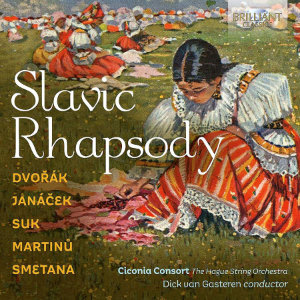
Slavic Rhapsody
Antonín Dvořák (1841-1904)
Serenade for Strings in E major, B.52 (1876)
Leoš Janáček (1854-1928)
Suite for String Orchestra, JW6 No. 2 (1877)
Josef Suk (1874-1935)
Meditace na staročeský ‘Svatý Václave’, Op. 35a (1914)
Bohuslav Martinů (1890-1959)
Suite No. 1 for String Orchestra ‘Partita’ H212 (1931)
Bedřich Smetana (1824-1884)
Rybář (The Fisherman) for harmonium, harp, and strings, JB1:97 (1869)
Ciconia Consort/Dick van Gasteren
rec. 2021, Westvestkerk, Schiedam, The Netherlands
Brilliant Classics 96737 [70]
Slavic Rhapsody is one of a series of recordings by the Ciconia Consort, the Hague String Orchestra of twenty young musicians, founded in 2012 under the leadership of Dick van Gasteren. They have recorded other nationalistic music before, including a disc of French music for string orchestra and one called American Pioneers. This time the focus is on the leading Czech composers of the nineteenth and twentieth centuries. Interestingly, none of the works here is a rhapsody. Since all of the music is for strings, one wouldn’t expect to find one of Dvořák’s Slavonic Rhapsodies, Janáček’sTaras Bulba, or Martinů’s Rhapsody-Concerto. Instead, we are presented with examples of string music, most of which are not among the respective composer’s best-known pieces. The exception is the Dvořák String Serenade that has received numerous performances and recordings, sometimes with his Wind Serenade accompanying it on disc. All of the music on this CD is well worth hearing, however, and the programme as a whole is well constructed.
Dvořák’s Serenade for Strings needs little introduction. It is one of his most beloved works. Ciconia Consort was new to me, but I have been very impressed with the results here. Dick van Gasteren and his orchestra contribute a very good account of the piece, emphasizing the rhythmic elements and accented notes. His may not be the warmest performance, with the upper strings occasionally taking on some glare and brightness. Undoubtedly the recording is partly responsible for this impression. Overall, I still prefer the Marriner and St. Martin-in-the-Field recording on Philips, which also contains the Wind Serenade, for its warmth and more relaxed atmosphere.
Janáček’s Suite, on the other hand, is neither popular nor characteristic of the composer we all know and esteem. It is an early work that Janáček wrote when he was 23 years old, long before he established his very personal voice. The Suite displays influences not only of Dvořák, but also Bruckner and Wagner. The work’s six movements possess substantial variety, beginning with a dark and dramatic theme in unison strings that reminded me of the opening of Franck’s Symphonic Variations. Contrasting this is a quiet and wistful slow movement I found quite beautiful. Then in turn a very short, lively folk dance with a simple, catchy tune. The following movement, a scherzo, indicates that Janáček knew his Beethoven, or maybe Mendelssohn as well. The fifth movement, marked Adagio, starts with unison strings in the lower register similar to the beginning of the suite, but becomes lyrical with beautiful harmony and a feeling of meditation. Janáček should have ended there, for the finale is the least successful of the six movements and meanders somewhat in its melancholy, though it has its charms, too. The Ciconia Consort play the piece as well as can be expected, but cannot turn it into any kind of masterpiece enjoyable as it is.
The other multi-movement work on the CD is Martinů’s Suite No. 1, also called Partita. This is from the composer’s neo-Baroque period when he produced many concertos and chamber music for various combinations of instruments. The prolific Martinů never ceases to amaze me in the quality and inventiveness of his music. I had not heard this suite before, but I am sure I will be listening to it again. The delightful piece is in four movements, none of them really slow. The first, marked Poco allegro, is lively with a jolly theme played pizzicato and ostinatos throughout. It also features the composer’s typical key changes. This is followed by a Moderato movement with punchy, dissonant chords. It is quite spiky and has a stomping dance rhythm. The third movement, Andante moderato, is light, tuneful, and motoric. The finale, marked Poco allegretto, is slightly quicker. It is also sunny and rhythmic that betrays the influence of his mentor, Albert Roussel. The Ciconia Consort seem to be have fun with the work, as the listener will undoubtedly have.
The remainder of the disc contains two shorter pieces by Suk and Smetana, respectively. Suk composed his Meditation on the Old Czech Chorale St. Wenceslas for string quartet and later arranged it for string orchestra. He composed it in August 1914 after the outbreak of World War I. The piece starts pensively, but with anticipation of something tragic and builds to a powerful climax. It concludes peacefully on a major chord.
Smetana’s Rybář (the Fisherman), is based on a poem by Goethe that is helpfully printed in the CD booklet. Dick van Gasteren, who also contributed the useful notes on the works, thinks it can be “regarded as a preliminary study” to The Moldau and finds it “unmistakably reminiscent” of that work. Perhaps with its use of harp and its basis of watery imagery, one may agree. However, in its four-minute length it is not nearly the piece that its popular successor is. Van Gasteren and his musicians give a fine account of themselves.
Although the title of this CD may sound misleading, the programme of the five Czech composers works well and provides the listener with 70 minutes of pleasurable listening. The performances and recorded sound certainly enhance one’s enjoyment.
Leslie Wright
Help us financially by purchasing from





















